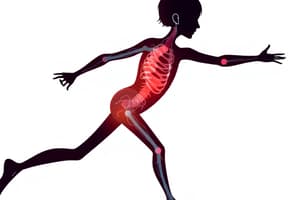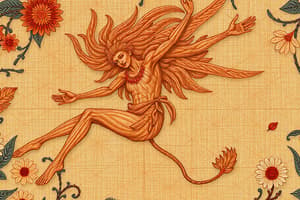Podcast
Questions and Answers
What are the three main types of movement?
What are the three main types of movement?
- Voluntary muscle actions, unconscious movements, fine motor skills
- Static movements, dynamic movements, rhythmic movements
- Involuntary movements, reflex responses, cognitive actions
- Reflex responses, voluntary movements, rhythmic motor patterns (correct)
Which of the following best describes the function of the pyramidal tracts?
Which of the following best describes the function of the pyramidal tracts?
- Regulate emotional responses
- Control conscious/voluntary movements (correct)
- Manage balance and posture
- Control involuntary movements
What muscles do the corticobulbar tract control?
What muscles do the corticobulbar tract control?
- Muscles in the head, face and neck (correct)
- Eyes and tongue
- Limbs and trunk
- Core muscles
Where are the cell bodies of the upper motor neurons of the pyramidal tracts primarily located?
Where are the cell bodies of the upper motor neurons of the pyramidal tracts primarily located?
Which tract primarily controls voluntary muscles?
Which tract primarily controls voluntary muscles?
Which of the following is NOT a function of the frontal lobe?
Which of the following is NOT a function of the frontal lobe?
Which descending pathway is involved in controlling unconscious movements?
Which descending pathway is involved in controlling unconscious movements?
What are the two tracts involved in voluntary movements?
What are the two tracts involved in voluntary movements?
What type of neurons are Betz and non-Betz cells, and where are they primarily located?
What type of neurons are Betz and non-Betz cells, and where are they primarily located?
Which statement accurately describes the role of the premotor cortex?
Which statement accurately describes the role of the premotor cortex?
What function is primarily associated with the supplementary motor area (SMA)?
What function is primarily associated with the supplementary motor area (SMA)?
Which of the following brain regions does the motor cortex send axons to, directly or indirectly?
Which of the following brain regions does the motor cortex send axons to, directly or indirectly?
What aspect of motor function do Betz and non-Betz cells primarily influence?
What aspect of motor function do Betz and non-Betz cells primarily influence?
Why is feedback from the basal ganglia and cerebellum important for the motor cortex?
Why is feedback from the basal ganglia and cerebellum important for the motor cortex?
The primary function of the motor cortex is to:
The primary function of the motor cortex is to:
Which area is located anterior to the primary motor cortex and is involved in movement planning?
Which area is located anterior to the primary motor cortex and is involved in movement planning?
What does the somatic motor system primarily control?
What does the somatic motor system primarily control?
Which type of muscle is controlled by the autonomic motor system?
Which type of muscle is controlled by the autonomic motor system?
What is the function of cardiac pacemaker cells?
What is the function of cardiac pacemaker cells?
How does the autonomic motor system differentiate neurotransmitters?
How does the autonomic motor system differentiate neurotransmitters?
Which of the following statements is true regarding the diaphragm?
Which of the following statements is true regarding the diaphragm?
What is a key similarity between the somatic and autonomic motor systems?
What is a key similarity between the somatic and autonomic motor systems?
Which muscle types are involved in the esophagus's control?
Which muscle types are involved in the esophagus's control?
How do the autonomic and somatic systems control their target tissues?
How do the autonomic and somatic systems control their target tissues?
What regions of the brain does the motor cortex send axons to in order to control movement?
What regions of the brain does the motor cortex send axons to in order to control movement?
Which voluntary movements are specifically controlled by the corticobulbar tracts?
Which voluntary movements are specifically controlled by the corticobulbar tracts?
Where are the lower motor neurons associated with the corticobulbar tract located?
Where are the lower motor neurons associated with the corticobulbar tract located?
How do the corticospinal tracts decussate and what types are formed?
How do the corticospinal tracts decussate and what types are formed?
Which of the following cranial nerves does NOT have a somatic motor component?
Which of the following cranial nerves does NOT have a somatic motor component?
What is the role of the axons sent by the motor cortex to other brain regions?
What is the role of the axons sent by the motor cortex to other brain regions?
What white matter areas do the corticospinal tracts travel through as they descend?
What white matter areas do the corticospinal tracts travel through as they descend?
How does the corticobulbar tract connect to the lower motor neurons?
How does the corticobulbar tract connect to the lower motor neurons?
What role does the prefrontal cortex play in motor control?
What role does the prefrontal cortex play in motor control?
How does the posterior parietal cortex contribute to motor output?
How does the posterior parietal cortex contribute to motor output?
What is the primary function of the somatosensory cortex in relation to motor control?
What is the primary function of the somatosensory cortex in relation to motor control?
What role does the cerebellum play in motor control?
What role does the cerebellum play in motor control?
Which function is NOT associated with the basal ganglia?
Which function is NOT associated with the basal ganglia?
How does the thalamus contribute to motor systems?
How does the thalamus contribute to motor systems?
Which area provides sensory information that is crucial for guiding movements?
Which area provides sensory information that is crucial for guiding movements?
What function does the prefrontal cortex NOT directly perform?
What function does the prefrontal cortex NOT directly perform?
Study Notes
Motor Systems
- Somatic Motor System: Controls voluntary and involuntary contraction of skeletal muscle.
- Autonomic Motor System: Controls involuntary contraction of smooth muscles, cardiac muscles, and gland secretions.
- Diaphragm: A skeletal muscle under voluntary and involuntary control for breathing.
- Esophagus: Contains both smooth and striated muscle, controlled by both the autonomic and somatic nervous systems.
Movement Production
- Movement is produced by contraction and relaxation of skeletal muscles.
- Three Types of Movement:
- Reflex Responses: Automatic responses like breathing, coughing, knee jerk, and withdrawal.
- Voluntary Movements: Consciously controlled movements like playing an instrument, peeling fruit, and typing.
- Rhythmic Motor Patterns: Repetitive movements like walking, running, and chewing.
Descending Motor Systems
- Pyramidal/Direct System: Controls conscious/voluntary movements through the corticobulbar and corticospinal tracts.
- Extrapyramidal/Indirect System: Controls unconscious/involuntary movement through three tracts and the rubrospinal tract for voluntary muscle control.
Pyramidal Tracts
- Corticobulbar Tract: Controls muscles of the head, face, and neck.
- Corticospinal Tract: Controls muscles below the neck, including limbs and trunk.
- Origin: Both tracts originate in the motor cortex (primarily primary motor cortex, but also premotor cortex and supplementary motor area).
Motor Cortex Function
- Controls voluntary movements.
- Provides input to involuntary movements.
- Receives input from:
- Prefrontal Cortex
- Somatosensory Cortex
- Posterior Parietal Cortex
- Thalamus (indirect input from basal ganglia and cerebellum)
Betz and Non-Betz Cells
- Upper motor neurons in layer 5 of the primary motor cortex, but likely present in other motor regions as well.
- Premotor Cortex: Located anterior to the primary motor cortex; plays a role in planning movement, spatial guidance, and understanding actions.
- Supplementary Motor Area (SMA): Located anterior to the primary motor cortex and dorsal to the premotor cortex; involved in posture stabilization, coordination of both sides of the body, and controlling movement sequences.
Motor Cortex Output
- The motor cortex sends axons to:
- Basal Ganglia
- Cerebellum (via the corticopontine tract)
- Thalamus (corticothalamic tract)
- Brainstem nuclei in the extrapyramidal tracts
- Function: Controls movement, potentially by sending a copy of planned movements for feedback and coordination.
Motor Input to Motor Cortex
- Prefrontal Cortex: Role in goal setting, decision-making, motivation, and cognitive control, providing some direct connections to the premotor cortex.
- Posterior Parietal Cortex (PPC): Plays a role in planning, sensory guidance, and motor commands.
- Somatosensory Cortex (Area 3a): May be functionally part of motor control circuitry, with direct connections to the motor cortex for sensory input.
- Cerebellum: Contributes to coordination, precision, and timing of movements.
- Basal Ganglia: Involved in the control, selection, and initiation of voluntary movements, procedural learning, and motivation.
- Thalamus: Relay station for information, including motor commands and feedback from the cerebellum.
Corticobulbar Tract
- Controls voluntary movements of the head, neck, face, mouth, and tongue.
- Upper motor neurons synapse on lower motor neurons and local circuit neurons in brainstem motor nuclei of cranial nerves III, IV, V, VI, VII, IX, X, XI, and XII.
Corticospinal Tract
- Travels through the corona radiata, internal capsule, and midbrain cerebral peduncles.
- Splits at the pyramids of the medulla.
- Lateral Corticospinal Tract: About 85-90% of axons cross over at the pyramids.
- Anterior Corticospinal Tract: About 10-15% of axons do not cross over.
- Both tracts descend separately in the spinal cord.
Studying That Suits You
Use AI to generate personalized quizzes and flashcards to suit your learning preferences.
Related Documents
Description
Explore the intricacies of the motor systems in the human body, including the somatic and autonomic motor systems. This quiz covers how movement is produced and the types of movements such as reflex responses, voluntary movements, and rhythmic motor patterns. Test your knowledge on the roles of various muscles involved in movement.




